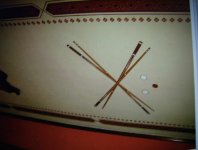I can probably answer number 3, he was friend with Maurice Vignaux,
I found the following (from google);
I wonder why a man should prefer a good billiard-table to a poor one; and why he should prefer straight cues to crooked ones; and why he should prefer round balls to chipped ones; and why he should prefer a level table to one that slants; and why he should prefer responsive cushions to the dull and unresponsive kind. I wonder at these things, because when we examine the matter we find that the essentials involved in billiards are as competently and exhaustively furnished by a bad billiard outfit as they are by the best one. One of the essentials is amusement. Very well, if there is any more amusement to be gotten out of the one outfit than out of the other, the facts are in favor of the bad outfit. The bad outfit will always furnish thirty per cent. more fun for the players and for the spectators than will the good outfit. Another essential of the game is that the outfit shall give the players full opportunity to exercise their best skill, and display it in a way to compel the admiration of the spectators. Very well, the bad outfit is nothing behind the good one in this regard. It is a difficult matter to estimate correctly the eccentricities of chipped balls and a slanting table, and make the right allowance for them and secure a count; the finest kind of skill is required to accomplish the satisfactory result. Another essential of the game is that it shall add to the interest of the game by furnishing opportunities to bet. Very well, in this regard no good outfit can claim any advantage over a bad one. I know, by experience, that a bad outfit is as valuable as the best one; that an outfit that couldn't be sold at auction for seven dollars is just as valuable for all the essentials of the game as an outfit that is worth a thousand. ... Last winter, here in New York, I saw Hoppe and Schaefer and Sutton and the three or four other billiard champions of world-wide fame contend against each other, and certainly the art and science displayed were a wonder to see; yet I saw nothing there in the way of science and art that was more wonderful than shots which I had seen Texas Tom make on the wavy surface of that poor old wreck in the perishing saloon at Jackass Gulch forty years before.
- Mark Twain's Autobiography, Chapters from the North American Review, November 1907
New York) Sun, Tuesday, March 6, 1883
VIGNAUX'S BALK-LINE PLAY.
_____
About 250 gentlemen met in response to this invitation:
The pleasure of your company is requested at an exhibition to be given by Maurice Vignaux to the members of the press at Madison Square Hall, 948 Broadway, on Monday, March 5, at 3 P.M.
Among those present were Judge Brady, Judge Roosevelt, Col. Fellows, Mark Twain, Commodore Brady, C. D. Keep, Daniel Strauss, William Sexton, Joseph Dion, Maurice Daly, the Dwyer brothers, James Kelly, L. O. Appleby, Henry Stedeker, C. Davis, and a host of other sporting men.
When all were seated and Mr. Vignaux appeared ready for play Mark Twain, who had been chatting with a friend at the end of a row of seats back of the table, arose and said:
GENTLEMAN: Please give me your attention for a minute. I have been called upon by Mr. O'Connor to introduce the distinguished gentleman from abroad. If there is one thing that I understand and like better than another it is introducing people. This time I am better fixed than when I was first introduced to the public. On that occasion a prominent citizen said that he would introduce me to the audience if I would find some responsible man to apologize for him after any lecture was over. If there is anything that Mr. Vignaux cannot do, gentlemen, call upon me and I'll do it.
After the applause and laughter had subsided rm. Vignaux and Mr. Sexton stepped to the table to play 300 points up at what is called the balk-line game of billiards ...
 Here is a photo of Twain's ceiling in his third floor billiard room at his Hartford Ct. residence. If you look carefully you will notice there are 4 cues crossed and it looks like of the four two are carom cues judging by the tappered shafts. Also there are 3 balls depicted. In photos with twain standing at his pocket billiard table there are three balls shown in several photos I have seen. My questions are as follows;
Here is a photo of Twain's ceiling in his third floor billiard room at his Hartford Ct. residence. If you look carefully you will notice there are 4 cues crossed and it looks like of the four two are carom cues judging by the tappered shafts. Also there are 3 balls depicted. In photos with twain standing at his pocket billiard table there are three balls shown in several photos I have seen. My questions are as follows;